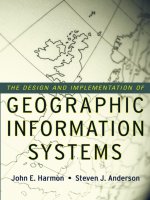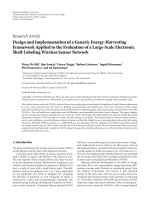Design and Implementation of VLSI Systems_Lecture 07: Sequential Circuit Sign potx
Bạn đang xem bản rút gọn của tài liệu. Xem và tải ngay bản đầy đủ của tài liệu tại đây (1.14 MB, 53 trang )
Design and Implementation
of VLSI Systems
Lecture 07
Thuan Nguyen
Faculty of Electronics and Telecommunications,
University of Science, VNU HCMUS
Spring 2011
1
LECTURE 07: SEQUENTIAL CIRCUIT
DESIGN
Introduction
1
Circuit Design of Latches and Flip-flops
2
Sequencing Static Circuits
3
2
Static Sequencing Element Methodology
4
Synchronizer
5
LECTURE 07: SEQUENTIAL CIRCUIT
DESIGN
Sequencing
1
Sequencing Element Design
2
Sequencing Methods
3
3
Introduction
1
Circuit Design of Latches and Flip-flops
2
Sequencing Static Circuits
3
Static Sequencing Element Methodology
4
Synchronizer
5
SEQUENCING
Combinational logic
Output depends on current inputs
Sequential logic
Output depends on current and previous inputs
Requires separating previous, current, future
Called state or tokens
Ex: FSM, pipeline
CL
clk
in out
clk clk clk
CL CL
PipelineFinite State Machine
4
SEQUENCING (CONT.)
If tokens moved through pipeline at constant
speed, no sequencing elements would be
necessary
Ex: fiber-optic cable
Light pulses (tokens) are sent down cable
Next pulse sent before first reaches end of cable
No need for hardware to separate pulses
But dispersion sets min time between pulses
This is called wave pipelining in circuits
In most circuits, dispersion is high
Delay fast tokens so they don’t catch slow ones.
5
SEQUENCING OVERHEAD
Use flip-flops to delay fast tokens so they move
through exactly one stage each cycle.
Inevitably adds some delay to the slow tokens
Makes circuit slower than just the logic delay
Called sequencing overhead
Some people call this clocking overhead
But it applies to asynchronous circuits too
Inevitable side effect of maintaining sequence
6
LECTURE 07: SEQUENTIAL CIRCUIT
DESIGN
Sequencing
1
Sequencing Element Design
2
Sequencing Methods
3
7
Introduction
1
Circuit Design of Latches and Flip-flops
2
Sequencing Static Circuits
3
Static Sequencing Element Methodology
4
Synchronizer
5
SEQUENCING ELEMENTS
Latch: Level sensitive
a.k.a. transparent latch, D latch
Flip-flop: edge triggered
A.k.a. master-slave flip-flop, D flip-flop, D register
Timing Diagrams
Transparent
Opaque
Edge-trigger
D
Flop
Latch
Q
clk clk
D Q
clk
D
Q (latch)
Q (flop)
D
Flop
Latch
Q
clk clk
D Q
clk
D
Q (latch)
Q (flop)
8
LATCH DESIGN
Pass Transistor Latch
Pros
+ Tiny
+ Low clock load
Cons
V
t
drop
nonrestoring
backdriving
output noise sensitivity
dynamic
diffusion input
D Q
Used in 1970’s
9
LATCH DESIGN
Transmission gate
+ No V
t
drop
- Requires inverted clock
D Q
10
LATCH DESIGN
Inverting buffer
+ Restoring
+ No backdriving
+ Fixes either
Output noise sensitivity
Or diffusion input
Inverted output
D
X
Q
D Q
11
LATCH DESIGN
Tristate feedback
+ Static
Backdriving risk
Static latches are now essential
because of leakage
QD
X
12
LATCH DESIGN
Buffered input
+ Fixes diffusion input
+ Noninverting
QD
X
13
LATCH DESIGN
Buffered output
+ No backdriving
Widely used in standard cells
+ Very robust (most important)
- Rather large
- Rather slow (1.5 – 2 FO4 delays)
- High clock loading
Q
D
X
14
LATCH DESIGN
Datapath latch
+ smaller
+ faster
- unbuffered input
Q
D
X
15
FLIP-FLOP DESIGN
Flip-flop is built as pair of back-to-back latches
D Q
X
D
X
Q
Q
16
PULSE GENERATOR
17
ENABLE
Enable: ignore clock when en = 0
Mux: increase latch D-Q delay
Clock Gating: increase en setup time, skew
D Q
Latch
D Q
en
en
Latch
D
Q
0
1
en
Latch
D Q
en
D
Q
0
1
en
D Q
en
Flop
Flop
Flop
Symbol Multiplexer Design Clock Gating Design
18
RESET
Force output low when reset asserted
Synchronous vs. asynchronous
D
Q
Q
reset
D
Q
D
reset
Q
D
reset
reset
reset
Synchronous Reset Asynchronous ResetSymbol
Flop
D Q
Latch
D Q
reset reset
Q
reset
19
SET/RESET
Set forces output high when enabled
Flip-flop with asynchronous set and reset
D
Q
reset
set
reset
set
20
LECTURE 07: SEQUENTIAL CIRCUIT
DESIGN
Sequencing
1
Sequencing Element Design
2
Sequencing Methods
3
21
Introduction
1
Circuit Design of Latches and Flip-flops
2
Sequencing Static Circuits
3
Static Sequencing Element Methodology
4
Synchronizer
5
SEQUENCING METHODS
Flip-flops
2-Phase Latches
Pulsed Latches
Flip-Flops
Flop
Latch
Flop
clk
1
2
p
clk clk
Latch
Latch
p
p
1
1
2
2-Phase Transparent Latches Pulsed Latches
Combinational Logic
Combinational
Logic
Combinational
Logic
Combinational Logic
Latch
Latch
T
c
T
c
/2
t
nonoverlap
t
nonoverlap
t
pw
Half-Cycle 1 Half-Cycle 1
22
TIMING DIAGRAMS
t
pd
Logic Prop. Delay
t
cd
Logic Cont. Delay
t
pcq
Latch/Flop Clk->Q Prop. Delay
t
ccq
Latch/Flop Clk->Q Cont. Delay
t
pdq
Latch D->Q Prop. Delay
t
cdq
Latch D->Q Cont. Delay
t
setup
Latch/Flop Setup Time
t
hold
Latch/Flop Hold Time
Contamination and Propagation Delays
23
Aperture = t
setup
+ t
hold
TIMING DIAGRAMS (CONT.)
24
Flop
A
Y
t
pd
Combinational
Logic
A Y
D Q
clk
clk
D
Q
Latch
D Q
clk
clk
D
Q
t
cd
t
setup
t
hold
t
ccq
t
pcq
t
ccq
t
setup
t
hold
t
pcq
t
pdq
t
cdq
MAX-DELAY: FLIP-FLOPS
F1
F2
clk
clk clk
Combinational Logic
T
c
Q1 D2
Q1
D2
t
pd
t
setup
t
pcq
setup
sequencing overhead
pd c pcq
t T t t
25









